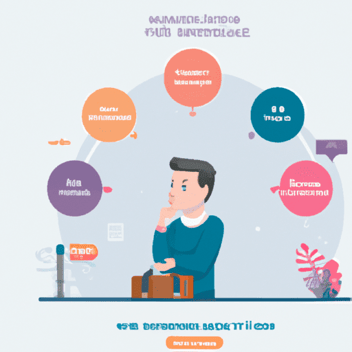The Buyer's Journey: Best Content for the Decision Stage
Welcome to the final stage of the buyer's journey: the decision stage. Potential customers have compared features, weighed options, and now they're staring down the final hurdle: choosing YOU. This is the decision stage of the buyer's journey, a make-or-break moment where the right content can seal the deal.
Understanding the Buyer's Journey: Decision Stage
The decision stage of the buyer’s journey represents the conclusive phase where potential customers are poised to purchase. It's the juncture where their extensive research, consideration, and evaluation culminate in the final decision-making process. Understanding this stage is vital for businesses aiming to tailor their strategies effectively, ensuring they meet the specific needs of their audience at this critical juncture.
At this juncture, the potential buyer is no longer exploring options; they’re on the verge of taking action. The significance of the decision stage lies in its transformative nature, as it marks the transition from prospect to customer. Businesses must recognize the unique mindset of consumers in this stage, characterized by a desire for clarity, reassurance, and detailed information that will guide them to the optimal choice.
The Role of Content
Providing In-depth Information
Content is pivotal in the decision stage by offering comprehensive and detailed information. Blog posts, product guides, and comparison articles are valuable resources that address buyers' queries. The content should clarify how the product or service aligns with the buyer's needs and smoothen their decision-making process.
Building Trust and Confidence
In the decision stage, trust becomes a deciding factor. Content can be used to build trust by showcasing testimonials, reviews, and case studies. Buyers are more likely to convert when they see real-world examples of others who have successfully navigated the decision-making process. This not only instills confidence but also reinforces the credibility of the brand or product.
Facilitating Decision-Making
Interactive content, like interactive product tours or live demonstrations, can engage the buyer and assist them in visualizing their experience with the product. This not only provides a more immersive understanding but also helps in solidifying the buyer's choice.
Best Content for the Decision Stage
Crafting content that resonates with buyers' unique needs and queries during this stage is pivotal for businesses aiming to secure conversions. Let's explore three powerful types of content that shine brightest in the decision stage, providing valuable insights and facilitating informed choices.
1. Testimonials, Reviews, and Case Studies
Testimonials, reviews, and case studies wield immense influence during the decision stage. At this juncture, potential customers seek reassurance and tangible proof that the product or service in question delivers on its promises. Testimonials from satisfied customers provide a human touch, offering authentic accounts of positive experiences.
88% of B2B marketers say case studies are the most effective content for generating leads.
Testimonials serve as social proof, demonstrating that others have successfully navigated the decision-making process and are now satisfied customers. They help build trust and credibility, addressing potential buyers' lingering doubts. When a prospect sees someone with a similar need or challenge expressing satisfaction, it reinforces the belief that the product or service is a reliable choice.
Reviews on the company's website, third-party review platforms, or social media play a pivotal role in shaping perceptions. Potential customers often rely on the experiences of their peers to gauge the performance, reliability, and satisfaction level associated with a product or service. Positive reviews can be persuasive, while businesses must proactively address and manage negative feedback to mitigate concerns.
Case studies take the testimonial concept further by providing a detailed narrative of a customer's journey. They showcase the specific challenges faced, the solutions implemented, and the positive outcomes achieved. This in-depth exploration helps potential buyers envision their own success story, making case studies a potent tool for businesses aiming to influence decisions.
2. Product Tours and Live Demonstrations
Interactive content stands out in the decision stage by offering potential buyers a hands-on and engaging experience. Product tours and live demonstrations provide a dynamic way for customers to explore the features and benefits of a product or service in real time.
Product tours allow potential buyers to explore the product's functionalities and user interface virtually. This interactive experience provides a deeper understanding of the product's capabilities, helping users envision how it will address their needs. Businesses can guide users through key features, highlight unique selling points, and address common concerns visually compellingly.
Whether through webinars, virtual events, or one-on-one sessions, live demonstrations create an interactive space for potential customers to ask questions and receive instant responses. This real-time interaction builds a connection and effectively lets businesses showcase the product's value proposition. Live demonstrations are particularly impactful for complex products or services that benefit from a detailed explanation.
67% of B2B buyers are more likely to buy after experiencing a live product demo.
Interactive content educates and empowers potential buyers to make more informed decisions. It provides a tangible experience that goes beyond static information, helping users evaluate the product more dynamically and personally. This can significantly reduce uncertainty and contribute to a smoother decision-making process.
3. Blog Articles, Product Guides, and Comparison Articles
Informative content in the form of blog articles, product guides, and comparison pieces serves as a valuable compass for potential buyers navigating the decision stage. These content types provide detailed information, address specific queries, and guide buyers toward making well-informed choices.
Educational Blog Articles
Blog articles that delve into the specifics of a product or service can be instrumental in the decision-making process. These pieces can cover various topics, from in-depth product features to how-tos and best practices. By providing valuable insights, businesses position themselves as authorities in their niche and offer a resource hub for potential buyers seeking detailed information.
Comprehensive Product Guides
Product guides go beyond surface-level information, offering a deep dive into the intricacies of a product. They can include detailed specifications, use cases, and practical tips for optimizing the product's performance. A well-crafted product guide is a go-to resource for potential buyers looking for comprehensive information to aid their decision-making.
Strategic Comparison Articles
Comparison articles, pitting the product or service against competitors, assist potential buyers in evaluating options objectively. These pieces highlight key differentiators, advantages, and potential drawbacks, helping customers weigh their choices more effectively. Strategic comparison articles guide buyers toward a decision by presenting a clear picture of how the offering stacks up against alternatives in the market.
54% of shoppers buy online because they can efficiently compare.
Blog articles, product guides, and comparison pieces collectively contribute to the buyer's decision-making process by providing the information needed to evaluate options thoroughly. These content types empower potential buyers with the knowledge required to make a choice aligned with their specific needs and preferences.
Content Tips for the Decision Stage
As bloggers and content creators begin crafting content for the decision stage, it's crucial to understand the significance of this pivotal stage in the buyer's journey. The decision stage marks the culmination of a potential customer's exploration, where they transition from considering options to making a final choice, and acknowledging this shift in mindset positions bloggers to tailor content that precisely addresses the unique needs and inquiries that arise during this crucial phase.
At this point, potential customers are no longer passively absorbing information but actively seeking reassurance and validation. The mindset is characterized by a desire for clarity, detailed information, and the confidence to make a well-informed decision. Bloggers must comprehend these nuances to craft content that resonates, providing the necessary support and guidance through this decisive journey.
Blog Headlines for Decision Stage Content
-
Attention-grabbing headlines: Attention-grabbing headlines are the gateway to capturing the interest of potential buyers in the decision stage. Bloggers must recognize the importance of crafting headlines that are compelling and resonate with the specific concerns and aspirations of the audience at this critical juncture. The headline is the first impression and must entice readers to delve into the content for valuable insights.
-
Examples of effective headlines:
-
Elevate Your Home Office: Choosing the Perfect Ergonomic Chair for Ultimate Comfort
-
Tech Unleashed: A Comprehensive Guide to Selecting Your Ideal Smart Home System
-
Revolutionize Your Fitness Journey: Your Ultimate Guide to Picking the Perfect Home Gym Equipment
-
-
SEO strategies: Integrating SEO strategies into headline creation is paramount for enhancing visibility. Bloggers should prioritize relevant keywords, strategically placing them to attract organic search traffic. Crafting meta-titles and descriptions that align with common decision-stage queries further ensures that the content is discoverable by potential buyers actively seeking solutions.
Key Questions to Answer in Decision Stage Content
The foundation of effective decision-stage content lies in identifying the key questions swirling in the minds of potential buyers. Bloggers must conduct thorough research to understand the queries that commonly arise at this stage. Pinpointing these questions about product features, pricing, or comparisons with alternatives informs the content creation process.
Once the questions are identified, content marketers must seamlessly integrate solutions into their content. Whether through detailed explanations, visual aids, or real-life examples, the content should serve as a resource hub that directly addresses the concerns of potential buyers. By providing solutions, bloggers become trusted guides, fostering a sense of reliability and expertise.
Decision-making concerns can range from fears of making the wrong choice to uncertainties about post-purchase experiences. Bloggers must anticipate and address these concerns head-on. Incorporating testimonials, success stories, and practical tips into the content helps alleviate apprehensions, guiding potential buyers toward decisions aligned with their preferences and needs.
Here are some common questions prospects ask in the decision stage:
-
Question: "How does this product/service compare to alternatives in the market?"
-
Answer: Our comprehensive guide will break down the key features that set our product apart and provide a side-by-side comparison with competitors.
-
-
Question: "What specific benefits does this product offer, and how will it meet my unique needs?"
-
Answer: Explore how our product caters to your needs with in-depth insights into its functionalities, ensuring you make an informed decision aligned with your preferences.
-
-
Question: "Can I see real-life examples of people who have successfully used this product or service?"
-
Answer: Dive into our collection of case studies and testimonials, providing firsthand experiences to help you visualize the positive outcomes of choosing our solution.
-
-
Question: "How does this product fit into my existing setup or routine?"
-
Answer: Delve into our guide on integration possibilities, showcasing how seamlessly our product can become an integral part of your current setup.
-
-
Question: "What additional costs should I consider, such as maintenance or subscription fees?"
-
Answer: Uncover the full cost picture with our breakdown of potential additional expenses, ensuring transparency and helping you plan accordingly.
-
-
Question: "Are there different versions or packages available, and how do I choose the right one for me?"
-
Answer: Navigate through our product options guide, helping you understand the features of each version and choose the one that aligns perfectly with your requirements.
-
-
Question: "Can I customize or tailor the product to better suit my preferences?"
-
Answer: Uncover the possibilities for customization in our in-depth guide, ensuring you understand how our product can be tailored to meet your unique preferences.
-
Empowering Decisions: Navigating the Path to Conversion
Crafting content for the decision stage guides potential buyers and presents valuable conversion opportunities for businesses. As content creators develop content for this stage, they pave the way for readers to transition seamlessly from consideration to deciding to take action and purchase.
By recognizing the potential for conversion within carefully curated content like blogs, case studies, and product demonstrations, businesses can transform casual interest into committed customer relationships, fostering growth and success in the dynamic landscape of the buyer's journey.










Leave a Comment